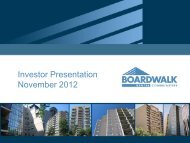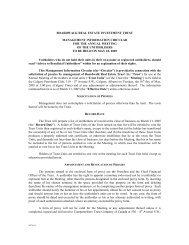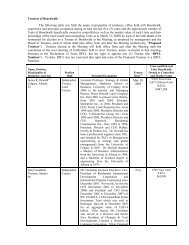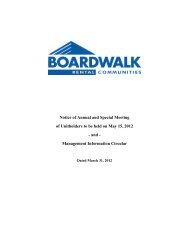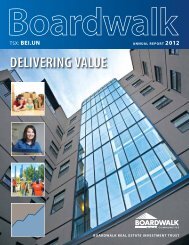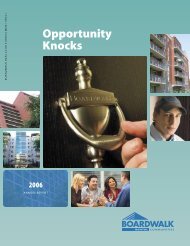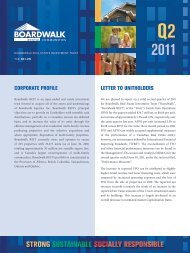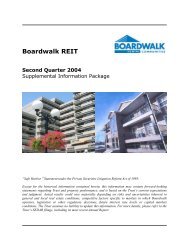BMO Financial Group - Outlook 2005(1.1Mb pdf File) - Boardwalk REIT
BMO Financial Group - Outlook 2005(1.1Mb pdf File) - Boardwalk REIT
BMO Financial Group - Outlook 2005(1.1Mb pdf File) - Boardwalk REIT
Create successful ePaper yourself
Turn your PDF publications into a flip-book with our unique Google optimized e-Paper software.
6<br />
Strong productivity growth...<br />
Labour Productivity<br />
Y/Y% Change, Nonfarm Business<br />
6.0<br />
5.0<br />
bound to moderate in <strong>2005</strong>, albeit to a<br />
still healthy clip of 2%. Further out, we<br />
see productivity growing at an estimated<br />
long-run trend of 2½% in 2006 – a full<br />
percentage point faster than the average<br />
between 1975 and 1995. Factoring in<br />
the usual 1% expansion of the labour<br />
force, this implies long-run potential<br />
growth of about 3½%.<br />
4.0<br />
3.0<br />
2.0<br />
1.0<br />
2001:Q1<br />
...has contained growth in jobs and labour costs...<br />
Nonfarm Payroll Employment<br />
M/M Change, Thousands<br />
...thereby keeping inflation in check.<br />
Consumer Price Index<br />
Y/Y% Change<br />
3.5<br />
3.0<br />
2.5<br />
2.0<br />
1.5<br />
350<br />
250<br />
150<br />
50<br />
-50<br />
-150<br />
-250<br />
Jan-02 Jul-02<br />
1.0<br />
2002:Q1<br />
Q3<br />
Q3<br />
Historical Average<br />
Jan-03<br />
Jul-03<br />
2003:Q1<br />
2002:Q1<br />
Jan-04<br />
Q3<br />
Jul-04<br />
2004:Q1<br />
Q3<br />
Unit Labour Costs<br />
Y/Y% Change, Nonfarm Business<br />
-2.0<br />
2001:Q1<br />
Q3<br />
3.0<br />
2.0<br />
1.0<br />
0.0<br />
-1.0<br />
2003:Q1<br />
<strong>2005</strong>:Q1<br />
2002:Q1<br />
FORECAST<br />
Q3<br />
Q3<br />
2003:Q1<br />
2006:Q1<br />
2004:Q1<br />
Core<br />
Overall<br />
Q3<br />
2004:Q1<br />
Inflation to remain controlled in <strong>2005</strong>…<br />
Rapid growth in productivity, by adding to<br />
the economy’s productive capacity and<br />
boosting profit margins, has helped to<br />
keep inflation in check. Although rising<br />
health care costs have pushed hourly<br />
compensation up 4.2% in the second<br />
quarter from a year earlier, unit labour<br />
costs still managed to decline by 0.3%<br />
owing to a 4.6% spurt in labour<br />
productivity. Accordingly, cost pressures<br />
have been subdued even in the face of<br />
soaring resource prices and a weakening<br />
dollar.<br />
Inflation at the consumer level, as<br />
measured by annual growth in the allitems<br />
CPI, has risen in 2004, but only<br />
moderately to 2.7% in August from 1.9%<br />
at the start of the year. Most of the<br />
increase has stemmed from the rising<br />
cost of gasoline and other energy<br />
products. An expected unwinding of<br />
energy costs should allow inflation to<br />
moderate to 1.9% in <strong>2005</strong>. The “core”<br />
CPI inflation rate, which excludes the<br />
volatile food and energy prices, has also<br />
climbed this year, but only to 1.7% in<br />
August from 1.1% in January. The upturn<br />
reflects higher costs of medical care and<br />
shelter. The core rate is projected to<br />
remain fairly steady at 1.8% in <strong>2005</strong> as<br />
the persistence of a small margin of slack<br />
in the economy should largely offset<br />
upward pressure on import prices<br />
stemming from the weaker dollar.





